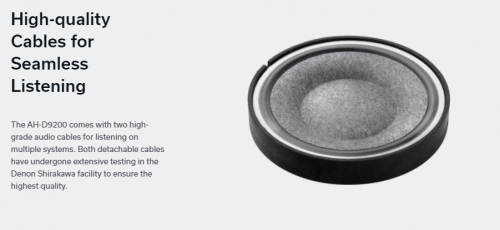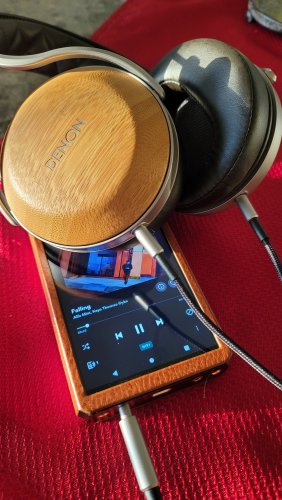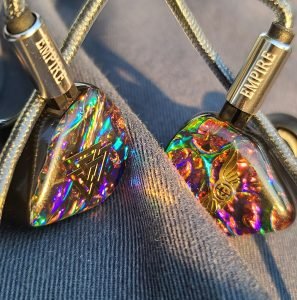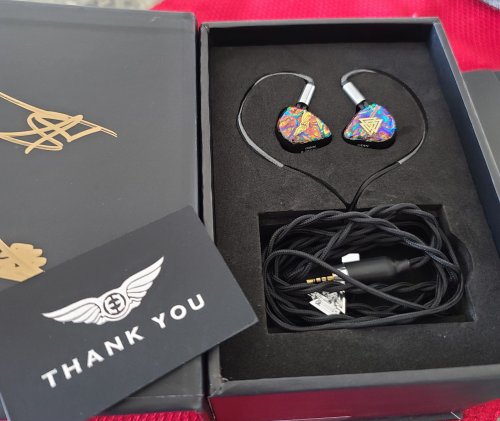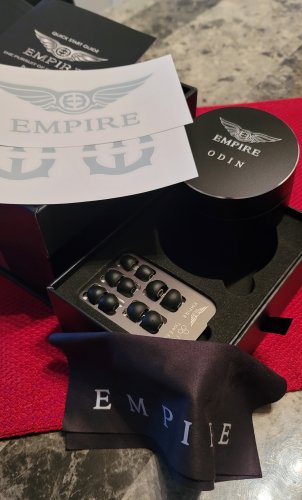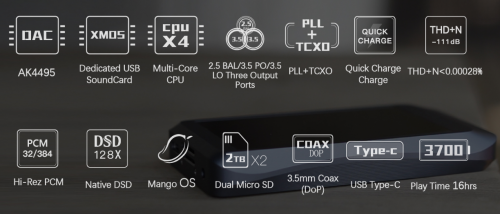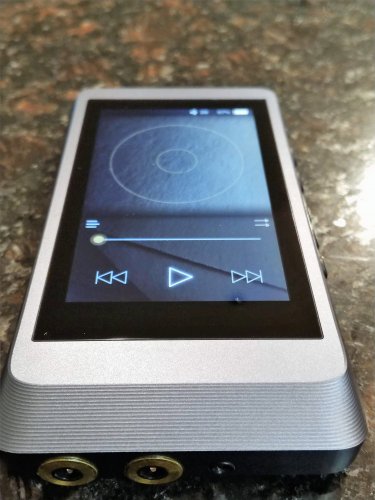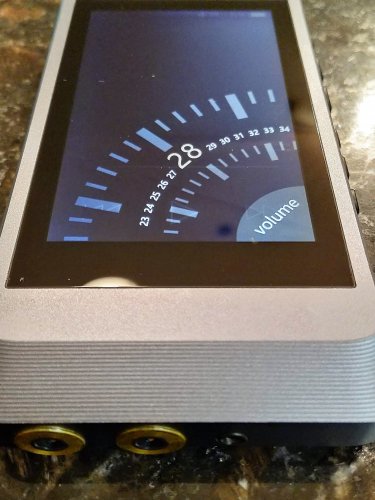EarSonics ONYX
EarSonics Store – Purchase ONYX
A Little Technical Stuff:
Specs
EarSonics is a French company that came into existence in 2005. The company originator is Franck Lopez, a bass player. The SM 64 was one of the first upper-tier monitors that lured me into this audio rabbit hole. Between Westone UM3X and EarSonics SM 64, I cycled through a few models of IEMs between these two companies as I discovered the hobby many moons ago.
Please look at my Head-Fi profile to see all of the IEMs I have owned from EarSonics as they are too numerous to list.
I wish for simpler times in this hobby again where spending $350-$500 was elite class. Unfortunately, some of the IEMs I owned are pushing the limits of $7000. I remember purchasing JH Audio Layla and sweating as I hit the “complete purchase” button. Now the Layla pricing is refreshing.
The return to value and quality with an IEM like ONYX is refreshing.
Companies such as EarSonics spend money developing new technology, whether in build quality or sound technology, which is good for the hobby.
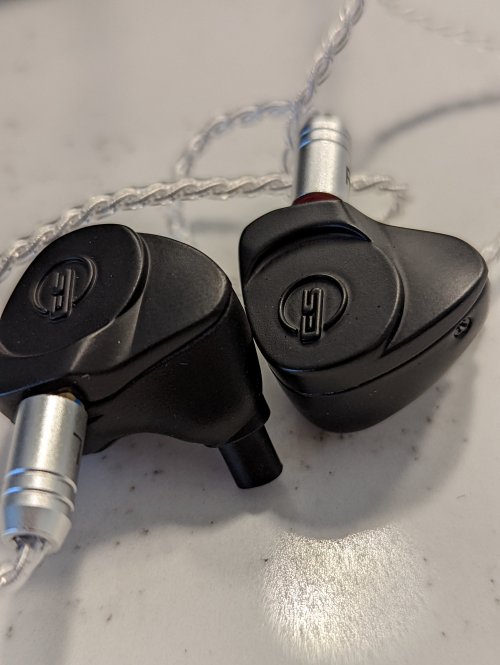
Unfortunately, as the ChiFi market grows, many companies that have been on the edge of R&D like EarSonics feel the pinch.
ChiFi puts a lovely façade on their product and sells it cheaper because they didn’t need to spend money on R&D, as other companies have already done. Not to mention the labor costs are very low relative to other countries.
The last EarSonics review I penned was for the Grace Platinum, their TOTL release. I like the Grace Platinum a lot, and you can read that review here; Grace Platinum.
I will also reference the EarSonics Stark during this review, and that review is here EarSonics Stark.
I was aware that the ONYX was in development for quite a while. However, like the other reviewers, I was not informed of any details, specs, or otherwise.
Similarly, I have been part of a blind review when Custom Art invited 10 of the “best reviewers” worldwide to participate. I know all of the reviewers during that blind review were surprised when they revealed the specs. This review has the same results; the specs and price points are the biggest surprises.
EarSonics involved a more representative cross-section of consumers in this blind review, not just the regular reviewers or fans of the brand.
I feel this type of review is a good idea. It eliminates bias toward the specs and pricing tier.
Once I saw the ONYX, its build and design were familiar and reminiscent of the EarSonics build over the last couple of years.
I was hoping for a sound signature between the Stark and the Grace, and ONYX delivered on that hope.
The Stark was a bass showcase release; it is evident that bass is its focus. At the same time, the ONYX has stellar bass quality with more forward upper mids and inoffensive treble. The Grace was more detailed than ONYX, but Grace Platinum can have an upper mid focus which can be more fatiguing for longer listens.
A Little Marketing Hype from their site, grammar aside:

GENESIS
The Onyx concept is born in the confinement context.
The team of enthusiasts engineers in charge of its development wondered what could be the best earphone that would meet the current requirement of audiophile public.
What started out as a concept turned into a real project.
The ONYX was born.
PROJECT
This team of passionated, the heart of the ONYX project, designed it based on the knowledge and know-how used in the Earsonics laboratories.
After several months of work, the first plans for the ONYX were here and with them the beginnings of an exceptional earphone.
To develop the ONYX, using the best materials was the leitmotif of the team.
A HEART AFFAIR.
When developing it, the engineering team used the best.
Thus, the ONYX is based, among other things, on the latest generation of 3D acrylic core used for the ONYX Platinum, Earsonics flagship.
A QUESTION OF ANGLE
The specific inclination of the ONYX body and cannula is the result of many years of research guaranteeing a comfortable fit and better insulation.

2 PINS CONNECTION
The use of "2 pins" is still today the safest and most efficient method to connect your in-ear headphones to their cable.
MANUFACTURING
Entirely handcrafted in our laboratories, the ONYX is designed to offer the highest level of quality at an unbeatable price in its range of high fidelity headphones.
This result underlines the commitment of the engineers on this project to satisfy the most demanding audiophiles.
SOUND
Through an approach aimed by a new sound bias, the ONYX is a 100% exclusive earphone with the dynamism, precision and balance primary characteristics.
DYNAMISM
At all sound volume ranges, you benefit from the entire sound spectrum thanks to the ONYX's ability to transcribe the dynamics. Its extension in the bass and the depth of the sound field also contribute to this dynamic presentation of the ONYX.
PRECISION
Rigorous care has been taken in the sound filtering of the ONYX. Its electronic circuit resulting from professional sound processing technologies, executes the information with precision and optimal control of the phase before feeding the transducers which deliver the sound.
BALANCE
Thanks to a skilful proportioning in the sound processing, the ONYX maintains a perfect balance and a faithful transcription of the timbres at all listening volumes.
AN EASY-TO-DRIVE MODEL.
This is the conclusion given by our engineers: its sensitivity-impedance couple allows the ONYX to work with all audio peripherals (sedentary DAC, DAP, walkmans, mobiles, etc.).
SOUND SIGNATURE.
The ONYX proved to be able to maintain balance and sonic rigor at high listening levels during our various tests. Triggering emotions, its signature designed in collaboration with Earsonics ensures a unique rendering.
WHAT’S IN THE BOX:
Included:

The ONYX arrives in a black box; ONYX colored, to be more precise, with the ES name and initials in the lower right corner. Once you flip open the lid, you see the monitors and the standard EarSonics zippered carry case. There is also a cardboard sleeve apparent in the box.
EarSonics carry cases are the best portable carry solution for my usage. I have used them for years to transport my IEMs when traveling for work or even just for storage, so simple yet convenient.

Once you open the zippered case, the ONYX greets you. Already cabled with a 2-pin non-balanced HR 4C Silver cable and a business-style card with the individual's name that handcrafted the IEM. A balanced cable would be a nice inclusion. However, I understand entirely that this would increase the price. Offering a bundle discount to include both cables might be a suggestion.

Inside the cardboard sleeve are the cleaning tool and the various eartips. I find it challenging to start criticizing EarSonics for the quality of the cable because I complained for years about them using the Plastics One cable. I am glad they have upgraded the offering, but it feels like a cheaply made upgrade.
Also, the ear tip offering is scant. Certainly could be more included.

I have learned through trial and error that I cannot ever achieve a solid seal with EarSonics stock tips and always reach for the Final E style tips. They always provide me with excellent seal and sound quality for EarSonics. The limited options of included ear tips are no big deal to me, but it might be to someone that doesn’t have a selection of tips at home.
Build Quality and Fit:
ONYX feels like the build could withstand a military attack, solid. That said, with the solid form comes additional weight. As a result, it is a heavy IEM.
The ONYX is well-built like the last 3 to 4 releases for EarSonics, with a metal outer shell. However, as I said, the excellent build and what feels to be a durable IEM has a downside; its weight might annoy you. The weight isn’t a deal-breaker, but I find myself fiddling with these while in my ear.

Size-wise, if you have small ears, there could be some fit issues. However, I have large earholes, and the ONYX does not give me any problems, except for weight. The shape of the monitor seems to work well.
The sound signature is so addictive that the slight trade-off of an occasional in-ear adjustment is worth it.
Review Setup:
I paired the ONYX with the Astell & Kern SP2Kt on Hybrid mode. If interested in the SP2Kt, I did a drive-by(mini-review) of the SP2Kt here Sp2000t.
Cable-wise, I listened using the stock 3.5mm cable and the EA EVO with a 4.4mm balanced plug. When using the EVO cable, the dynamics of the sound are improved. One of the most notable improvements is that the already stellar staging is even more defined. In addition, the ONYX sounds more dynamically charged on all fronts than with the stock cable. I am not reviewing the EVO cable; I only wanted to mention it.

My sample music consisted of 320kb, FLAC, 24bit, and streaming Tidal and Amazon Music HD.
For eartips, I found that the Final E tips gave me the best sound quality.
Moving on to the sound section….
It would be bold and capable if I were to characterize ONYX in a few words. The ONYX is a little bit of a marriage between the Grace Platinum and the Stark. The resolution and air separate it from the Stark, and the bass quantity separates it from the Grace Platinum.
ONYX is meaty, robust, and capable of providing enjoyment when listening to all genres of music.
Staging and imaging strike above similarly priced IEMs. It is not a super-wide stage, but it is wider than a square, with the depth providing a better impression than its width. It is not holographic, but the depth is apparent. I wouldn’t expect a holographic listen at this price point. However, it is certainly not the most intimate and closed-in IEM I have heard. The accuracy in its staging is also very impressive given the price. Realism without an exaggerated stage is how I would summarize.

ONYX is bass bold, like the Stark, but different. The bass quality is better in the ONYX, and the overall signature has much more air. ONYX’s tuning allows for plenty of bass quantity while respecting the rest of the signature; this results from excellent sound engineering.
The bass has a snappier decay, so the notes don’t linger as long as they do with the Stark. Less decay allows for more resolution and enables you to distinguish the layers in the bass frequencies.
Mid-bass is clean, precise, and does not interfere with the mid-range. Although I am trying to draw on my memory bank to recall a better-sounding mid-bass, the ONYX has to be one of the best. The control relative to other bass-focused IEMs is spectacular.
The Empire Ears fabled Legend X is an IEM that comes to mind when listening to the ONYX. The ONYX and X share some bass characteristics. Slamming DD bass is on the menu for both. Both the X and the ONYX have an immersive feel. However, I may say the ONYX has less bloom and slightly more definition in its bass and a better presence in the upper mid and lower treble frequency. ONYX has an overall airier feel when listening.
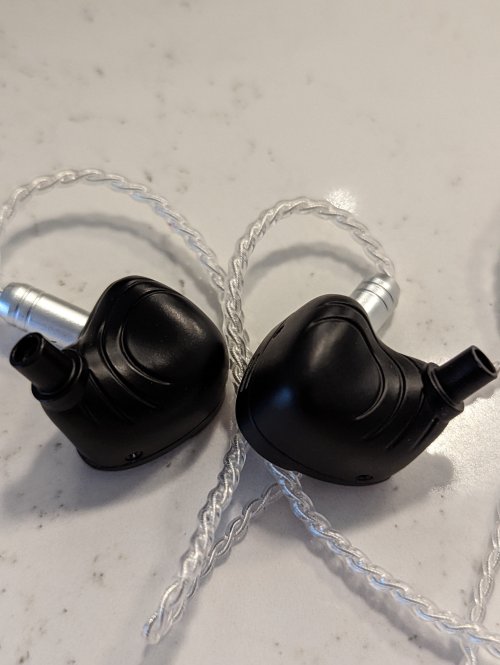
When you know that the owner of EarSonics, Franck, is a bassist himself, it connects the dots as to the focus toward quality and quantity bass in ONYX. Very well done!
The mid-range provides an excellent portrayal of vocals. That was one area that immediately stood out to me when I was critical and pleasure listening. The lower mids showcase male vocals, and the upper mids female. Next to the bass, vocals are the star of the show.
I do hear some lift in the upper mids, but nowhere near the level of Grace Platinum; it is more of a gradual rise. I read criticism of some of today's more upper mid-focused IEMs as too forward or too sharp and fatiguing. However, while there is presence in that range, I do not find it offensive, but rather assisting in balancing what could be a bassy signature. Likewise, the mids create a balanced listen.
Details are present, but nothing fatiguing. However, suppose you are into micro details. In that case, you may wish to look in another direction because that is not the strong suit of the ONYX.
To characterize the treble, one would have to say it is smooth with average extension. There is no harshness, no sharp tones, and good extension relative to the coherency of the signature. Again, you will not hear much twinkling to the fringe, but to repeat, it adds balance to the full signature.
The treble does roll-off, but it is my preferred signature. There is less sparkle than Grace Platinum more than Stark or Legend X. If bright treble is your thing, there is probably not enough treble presence for you. It is essential when pleasure listening to take in the entire ambiance and not focus on one frequency.
The treble is satisfying in my pleasure listening sessions and is undoubtedly a part of forming one excellent coherent package.
You might want to own this IEM if:
+ You want excellent bass, both in quality and quantity
+ You prefer a smooth, balanced, non-offensive treble
+ You prefer a sound that is bold and capable
+ You like a coherent stage with an incredible portrayal of vocals
In Closing
It is undoubtedly an honor and a pleasure to be part of the review group. The ONYX is one fantastic listen. In this closing, I am fighting not to overuse the phrase strike above its price point, but that is what the ONYX does.
The price inclusive of VAT for purchase within EU is 590 euros and without VAT 490 euros outside EU. I know it can be confusing to see prices quoted in some reviews, but this is the discrepancy in pricing.
There are a few comparisons to other IEMs sprinkled throughout the review. However, everything compared to ONYX costs quite a bit more. Knowing I am comparing ONYX to much higher-priced IEMs should speak for itself.

The bass is near the top of the list of the IEMs, both in quality and quantity. Of course, I am biased towards DD bass, but in the ONYX, the execution of DD bass is top-notch.
ONYX staging is accurate, and the Onyx strikes above its price point in this area. Using the Snarky Puppy Live From Richmond, a concert I attended, as my validation tool.
The treble is smooth, it is not the most sparkly treble, but the treble does blend very well with the full signature. However, this IEM probably won’t please you if you are a treble head.
One concern you can encounter with hybrid (multi-driver type) designs can be coherency. I can assure you there are no coherency issues with the ONYX.
I found this IEM to work well with all genres of music. For example, the speed and decay of the bass work well with jazz, and the quantity sometimes makes bass lighter genres such as classic rock sound spectacular.
The build quality is impeccable. Sturdy and durable but can be heavy in the ear. Whether the added weight gives you concern will be personal.
In closing, the ONYX is a homerun. Its sound and price captivate. When I listen for pleasure, my two current go-to’s are the Empire Ears EVO and the ONYX.
EarSonics Store – Purchase ONYX
A Little Technical Stuff:
Specs
- Sensitivity: 122 dB / mW
- Frequency response: 10 Hz -20 kHz
- DCR: 16,5 ohms
- Driver: 4 drivers(DD/BA) 1X dynamic bass, 2X balanced medium, 1X balanced treble with 3-way HQ impedance corrector
EarSonics is a French company that came into existence in 2005. The company originator is Franck Lopez, a bass player. The SM 64 was one of the first upper-tier monitors that lured me into this audio rabbit hole. Between Westone UM3X and EarSonics SM 64, I cycled through a few models of IEMs between these two companies as I discovered the hobby many moons ago.
Please look at my Head-Fi profile to see all of the IEMs I have owned from EarSonics as they are too numerous to list.
I wish for simpler times in this hobby again where spending $350-$500 was elite class. Unfortunately, some of the IEMs I owned are pushing the limits of $7000. I remember purchasing JH Audio Layla and sweating as I hit the “complete purchase” button. Now the Layla pricing is refreshing.
The return to value and quality with an IEM like ONYX is refreshing.
Companies such as EarSonics spend money developing new technology, whether in build quality or sound technology, which is good for the hobby.

Unfortunately, as the ChiFi market grows, many companies that have been on the edge of R&D like EarSonics feel the pinch.
ChiFi puts a lovely façade on their product and sells it cheaper because they didn’t need to spend money on R&D, as other companies have already done. Not to mention the labor costs are very low relative to other countries.
The last EarSonics review I penned was for the Grace Platinum, their TOTL release. I like the Grace Platinum a lot, and you can read that review here; Grace Platinum.
I will also reference the EarSonics Stark during this review, and that review is here EarSonics Stark.
I was aware that the ONYX was in development for quite a while. However, like the other reviewers, I was not informed of any details, specs, or otherwise.
Similarly, I have been part of a blind review when Custom Art invited 10 of the “best reviewers” worldwide to participate. I know all of the reviewers during that blind review were surprised when they revealed the specs. This review has the same results; the specs and price points are the biggest surprises.
EarSonics involved a more representative cross-section of consumers in this blind review, not just the regular reviewers or fans of the brand.
I feel this type of review is a good idea. It eliminates bias toward the specs and pricing tier.
Once I saw the ONYX, its build and design were familiar and reminiscent of the EarSonics build over the last couple of years.
I was hoping for a sound signature between the Stark and the Grace, and ONYX delivered on that hope.
The Stark was a bass showcase release; it is evident that bass is its focus. At the same time, the ONYX has stellar bass quality with more forward upper mids and inoffensive treble. The Grace was more detailed than ONYX, but Grace Platinum can have an upper mid focus which can be more fatiguing for longer listens.
A Little Marketing Hype from their site, grammar aside:

GENESIS
The Onyx concept is born in the confinement context.
The team of enthusiasts engineers in charge of its development wondered what could be the best earphone that would meet the current requirement of audiophile public.
What started out as a concept turned into a real project.
The ONYX was born.
PROJECT
This team of passionated, the heart of the ONYX project, designed it based on the knowledge and know-how used in the Earsonics laboratories.
After several months of work, the first plans for the ONYX were here and with them the beginnings of an exceptional earphone.
To develop the ONYX, using the best materials was the leitmotif of the team.
A HEART AFFAIR.
When developing it, the engineering team used the best.
Thus, the ONYX is based, among other things, on the latest generation of 3D acrylic core used for the ONYX Platinum, Earsonics flagship.
A QUESTION OF ANGLE
The specific inclination of the ONYX body and cannula is the result of many years of research guaranteeing a comfortable fit and better insulation.

2 PINS CONNECTION
The use of "2 pins" is still today the safest and most efficient method to connect your in-ear headphones to their cable.
MANUFACTURING
Entirely handcrafted in our laboratories, the ONYX is designed to offer the highest level of quality at an unbeatable price in its range of high fidelity headphones.
This result underlines the commitment of the engineers on this project to satisfy the most demanding audiophiles.
SOUND
Through an approach aimed by a new sound bias, the ONYX is a 100% exclusive earphone with the dynamism, precision and balance primary characteristics.
DYNAMISM
At all sound volume ranges, you benefit from the entire sound spectrum thanks to the ONYX's ability to transcribe the dynamics. Its extension in the bass and the depth of the sound field also contribute to this dynamic presentation of the ONYX.
PRECISION
Rigorous care has been taken in the sound filtering of the ONYX. Its electronic circuit resulting from professional sound processing technologies, executes the information with precision and optimal control of the phase before feeding the transducers which deliver the sound.
BALANCE
Thanks to a skilful proportioning in the sound processing, the ONYX maintains a perfect balance and a faithful transcription of the timbres at all listening volumes.
AN EASY-TO-DRIVE MODEL.
This is the conclusion given by our engineers: its sensitivity-impedance couple allows the ONYX to work with all audio peripherals (sedentary DAC, DAP, walkmans, mobiles, etc.).
SOUND SIGNATURE.
The ONYX proved to be able to maintain balance and sonic rigor at high listening levels during our various tests. Triggering emotions, its signature designed in collaboration with Earsonics ensures a unique rendering.
WHAT’S IN THE BOX:
Included:
- ONYX with is 4C-HR cable
- 1 Cleaning Tool.
- 2 pairs of Comply tips of different sizes.
- 2 pairs of silicon mono flange tips of various sizes.
- 2 pairs of silicon bi-flange tips of different sizes.
- 1 carrying case made from EarSonics.
- 1 User manual.

The ONYX arrives in a black box; ONYX colored, to be more precise, with the ES name and initials in the lower right corner. Once you flip open the lid, you see the monitors and the standard EarSonics zippered carry case. There is also a cardboard sleeve apparent in the box.
EarSonics carry cases are the best portable carry solution for my usage. I have used them for years to transport my IEMs when traveling for work or even just for storage, so simple yet convenient.

Once you open the zippered case, the ONYX greets you. Already cabled with a 2-pin non-balanced HR 4C Silver cable and a business-style card with the individual's name that handcrafted the IEM. A balanced cable would be a nice inclusion. However, I understand entirely that this would increase the price. Offering a bundle discount to include both cables might be a suggestion.

Inside the cardboard sleeve are the cleaning tool and the various eartips. I find it challenging to start criticizing EarSonics for the quality of the cable because I complained for years about them using the Plastics One cable. I am glad they have upgraded the offering, but it feels like a cheaply made upgrade.
Also, the ear tip offering is scant. Certainly could be more included.

I have learned through trial and error that I cannot ever achieve a solid seal with EarSonics stock tips and always reach for the Final E style tips. They always provide me with excellent seal and sound quality for EarSonics. The limited options of included ear tips are no big deal to me, but it might be to someone that doesn’t have a selection of tips at home.
Build Quality and Fit:
ONYX feels like the build could withstand a military attack, solid. That said, with the solid form comes additional weight. As a result, it is a heavy IEM.
The ONYX is well-built like the last 3 to 4 releases for EarSonics, with a metal outer shell. However, as I said, the excellent build and what feels to be a durable IEM has a downside; its weight might annoy you. The weight isn’t a deal-breaker, but I find myself fiddling with these while in my ear.

Size-wise, if you have small ears, there could be some fit issues. However, I have large earholes, and the ONYX does not give me any problems, except for weight. The shape of the monitor seems to work well.
The sound signature is so addictive that the slight trade-off of an occasional in-ear adjustment is worth it.
Review Setup:
I paired the ONYX with the Astell & Kern SP2Kt on Hybrid mode. If interested in the SP2Kt, I did a drive-by(mini-review) of the SP2Kt here Sp2000t.
Cable-wise, I listened using the stock 3.5mm cable and the EA EVO with a 4.4mm balanced plug. When using the EVO cable, the dynamics of the sound are improved. One of the most notable improvements is that the already stellar staging is even more defined. In addition, the ONYX sounds more dynamically charged on all fronts than with the stock cable. I am not reviewing the EVO cable; I only wanted to mention it.

My sample music consisted of 320kb, FLAC, 24bit, and streaming Tidal and Amazon Music HD.
For eartips, I found that the Final E tips gave me the best sound quality.
Moving on to the sound section….
It would be bold and capable if I were to characterize ONYX in a few words. The ONYX is a little bit of a marriage between the Grace Platinum and the Stark. The resolution and air separate it from the Stark, and the bass quantity separates it from the Grace Platinum.
ONYX is meaty, robust, and capable of providing enjoyment when listening to all genres of music.
Staging and imaging strike above similarly priced IEMs. It is not a super-wide stage, but it is wider than a square, with the depth providing a better impression than its width. It is not holographic, but the depth is apparent. I wouldn’t expect a holographic listen at this price point. However, it is certainly not the most intimate and closed-in IEM I have heard. The accuracy in its staging is also very impressive given the price. Realism without an exaggerated stage is how I would summarize.

ONYX is bass bold, like the Stark, but different. The bass quality is better in the ONYX, and the overall signature has much more air. ONYX’s tuning allows for plenty of bass quantity while respecting the rest of the signature; this results from excellent sound engineering.
The bass has a snappier decay, so the notes don’t linger as long as they do with the Stark. Less decay allows for more resolution and enables you to distinguish the layers in the bass frequencies.
Mid-bass is clean, precise, and does not interfere with the mid-range. Although I am trying to draw on my memory bank to recall a better-sounding mid-bass, the ONYX has to be one of the best. The control relative to other bass-focused IEMs is spectacular.
The Empire Ears fabled Legend X is an IEM that comes to mind when listening to the ONYX. The ONYX and X share some bass characteristics. Slamming DD bass is on the menu for both. Both the X and the ONYX have an immersive feel. However, I may say the ONYX has less bloom and slightly more definition in its bass and a better presence in the upper mid and lower treble frequency. ONYX has an overall airier feel when listening.

When you know that the owner of EarSonics, Franck, is a bassist himself, it connects the dots as to the focus toward quality and quantity bass in ONYX. Very well done!
The mid-range provides an excellent portrayal of vocals. That was one area that immediately stood out to me when I was critical and pleasure listening. The lower mids showcase male vocals, and the upper mids female. Next to the bass, vocals are the star of the show.
I do hear some lift in the upper mids, but nowhere near the level of Grace Platinum; it is more of a gradual rise. I read criticism of some of today's more upper mid-focused IEMs as too forward or too sharp and fatiguing. However, while there is presence in that range, I do not find it offensive, but rather assisting in balancing what could be a bassy signature. Likewise, the mids create a balanced listen.
Details are present, but nothing fatiguing. However, suppose you are into micro details. In that case, you may wish to look in another direction because that is not the strong suit of the ONYX.
To characterize the treble, one would have to say it is smooth with average extension. There is no harshness, no sharp tones, and good extension relative to the coherency of the signature. Again, you will not hear much twinkling to the fringe, but to repeat, it adds balance to the full signature.
The treble does roll-off, but it is my preferred signature. There is less sparkle than Grace Platinum more than Stark or Legend X. If bright treble is your thing, there is probably not enough treble presence for you. It is essential when pleasure listening to take in the entire ambiance and not focus on one frequency.
The treble is satisfying in my pleasure listening sessions and is undoubtedly a part of forming one excellent coherent package.
You might want to own this IEM if:
+ You want excellent bass, both in quality and quantity
+ You prefer a smooth, balanced, non-offensive treble
+ You prefer a sound that is bold and capable
+ You like a coherent stage with an incredible portrayal of vocals
In Closing
It is undoubtedly an honor and a pleasure to be part of the review group. The ONYX is one fantastic listen. In this closing, I am fighting not to overuse the phrase strike above its price point, but that is what the ONYX does.
The price inclusive of VAT for purchase within EU is 590 euros and without VAT 490 euros outside EU. I know it can be confusing to see prices quoted in some reviews, but this is the discrepancy in pricing.
There are a few comparisons to other IEMs sprinkled throughout the review. However, everything compared to ONYX costs quite a bit more. Knowing I am comparing ONYX to much higher-priced IEMs should speak for itself.

The bass is near the top of the list of the IEMs, both in quality and quantity. Of course, I am biased towards DD bass, but in the ONYX, the execution of DD bass is top-notch.
ONYX staging is accurate, and the Onyx strikes above its price point in this area. Using the Snarky Puppy Live From Richmond, a concert I attended, as my validation tool.
The treble is smooth, it is not the most sparkly treble, but the treble does blend very well with the full signature. However, this IEM probably won’t please you if you are a treble head.
One concern you can encounter with hybrid (multi-driver type) designs can be coherency. I can assure you there are no coherency issues with the ONYX.
I found this IEM to work well with all genres of music. For example, the speed and decay of the bass work well with jazz, and the quantity sometimes makes bass lighter genres such as classic rock sound spectacular.
The build quality is impeccable. Sturdy and durable but can be heavy in the ear. Whether the added weight gives you concern will be personal.
In closing, the ONYX is a homerun. Its sound and price captivate. When I listen for pleasure, my two current go-to’s are the Empire Ears EVO and the ONYX.



























